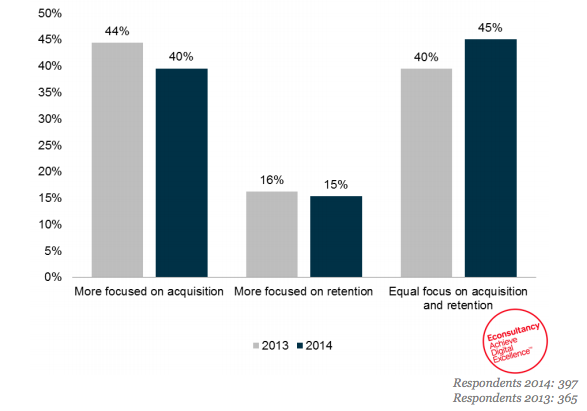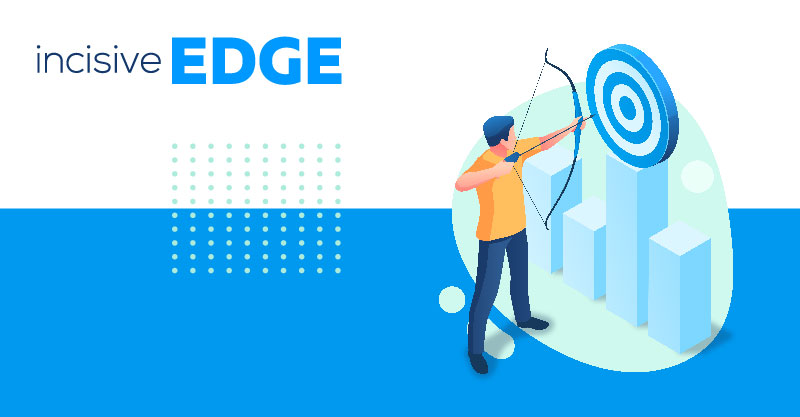You could be armed with a tool chest brimming with an array of the most sophisticated strategies in world – but the truth is, when it comes to growing your business, there are essentially two tactics at your disposal that all else boil down into:1) Attracting new visitors 2) Acquiring new customers; 2) Retaining existing customers and increasing customer lifetime value.
The knee-jerk reaction is to focus on option 1 – for surely, to venture briefly into the realms of algebra, more customers = more sales = more revenue = more profits = good times ahead.
It's an assumption that seems to have prevailed over the course of the years – even in spite of widespread acknowledgement that customer retention, from a marketing perspective, is cheaper than customer acquisition.
Check out these stats from Econsultancy's 2014 Cross-Channel Marketing Report, for instance. 82% of the 397 companies surveyed agreed that retention strategies were reduced customer acquisition costs.
However, in spite of this, 40% of those same companies were more focussed on customer acquisition, compared to just 15% which were more focussed on the more cost-effective practice of retention.

More recent figures confirm that the costs of customer retention are still far more favourable than those of acquisition – and what is more, existing customers generate much more revenue than new ones.
Indeed, Gartner says that “65% of a company's business comes from existing customers, and it costs five times as much to attract a new customer than to keep an existing one satisfied.” Which emphases the need to minimise the churn rate.
What is Customer Lifetime Value
Customer lifetime value is an important metric for businesses because it's cheaper to keep existing customers than it is to acquire new ones. That means increasing the value of your customer relationship is a great way to drive growth.
You will not be surprised (though understandably a little distressed) to learn that in order to calculate customer lifetime value (CLV), we will need to continue our foray into algebraic equations (and we'll have to be a little more scientific in our efforts this time).
Now, the equations we use can be as complicated as we like. But, let's begin with the basics.
How to Calculate Customer Lifetime Value Formula
First, we need to calculate the average annual profit contribution per customer, and we'll call this figure ‘X'.
Next, we need to calculate the average number of years a customer remains a customer, and we'll call this figure ‘Y'.
The third step is to work out the average initial cost of customer acquisition, and we'll call this figure ‘Z'.
Finally, we need to pump X, Y and Z into a formula, and it looks like this:
(XY) – Z = CLV (customer lifetime value)
Simple enough, right?
Well, let's use an example to ensure there's no confusion.
Let's say the profit generated each year by the average customer = £500 (X).
Now, let's assume that the average number of years that a customer remains a customer = 5 (Y).
So, now we have the X times Y part of the equation:
£500 (a year) x 5 (years) = £2,500
Back to the third step, let's say the average cost to acquire a new customer = £300 (Z).
Now we can load up the full equation again, replacing letters with figures:
(£500 x 5) – £300 = £2,200
Customer lifetime value = £2,200.
Unfortunately, It’s Not as Simple as That
Of course it isn't – but using the customer lifetime value formula above is useful nonetheless.
The complexity comes when you consider all the variables that come as part and parcel of all of your marketing, acquisition and customer retention efforts.
Indeed, if you really want to get into the nitty-gritty of customer lifetime value calculations, check out this 55-page academic study on the subject, which concludes (amongst many other things) the following:

Variables come in the form of discounts, returns, customer service costs, communications, etc., etc., etc. And that's not the only complication. Simply working out the average profit generated by each customer journey may be tricky.
If you're a SaaS company with, say, three basic subscription models, then perhaps this particular task won't be too difficult. However, if you've got a chain of high street stores dotted all over the country, then you're going to quickly find yourself in the realms of some pretty serious mathematics.
So, to give you the more thorough run-down of customer lifetime value calculations, we reproduce this infographic from Kissmetrics, which takes coffee shop chain Starbucks as an example for how to calculate customer lifetime value.
Click Image to Enlarge
Source: How To Calculate Lifetime Value
How to Improve Customer Lifetime Value
That's the end of the maths lesson, we promise.
In the end, what we need to remember is the fact that retaining customers is much more cost-effective than acquiring new ones, and that indeed most of our revenue comes from existing customers.
The challenge, then, is to improve the lifetime value of our existing customers. Below are some tried and trusted tactics for doing just that.
Nurture Your Relationships
We all like to feel loved and appreciated, and sometimes all it takes is a simple, personalised thank you note sent to your loyal customers to show them that you care.
As a minimum, you should of course be sending out thank you emails to all customers at the end of every purchase. But, in order to get the most out of your relationships and increase that all-important customer lifetime value, go a few steps further.
Every now and again, reach out to them, via email or social media, and nurture the relationship.
This tactic works best when you give something away dependant on the customer segment – perhaps you could upgrade your customers to faster, cheaper or even free shipping on all future orders as a way of saying thanks for their custom. If they're subscribers to a service, why not give them a discount for a couple of months, or offer them a temporary upgrade to a premium plan?
Entice Customers to Extend Subscription Duration
If you want to increase lifetime value, then of course you must extend the lifespan of your customers.
This means finding ways to ensure that your customers pay for your services over longer periods of time. For subscription models, it's likely that most of your customers will be paying monthly, with the inherent risk that any amount could cancel their subscriptions at any given time.
And so, if you can entice more of these customers to switch to an annual subscription, then you will at once decrease customer churn and increase the average customer lifespan (Y).
To do so, you will need to offer an incentive. For example, you could offer two months free for those customers that upgrade to an annual subscription. What's additionally beneficial about this tactic is that, as a by-product, you will achieve a cash flow boost – ready capital that you could use to supplement further growth and business/service improvements.
Remind Customers Why They Need You
Yes. This is important.
Your business will be solving a problem for your customers, and, as such, this where the value (from the customer's standpoint) lies. So, make a point of reminding your customers about the value you are providing.
For instance, let's say you've got a fitness app – once a week, you can remind your subscribers of your product's value by sending out an email containing their weekly stats, showing how their health and fitness have improved over time.
In the FinTech game? Great! Do the same thing, but remind your customers how much money you've managed to save them over the week, month and/or year.
Proving value will ensure that you increase loyalty amongst your paying customers.
Alert Customers to New Deals
If you've got an ecommerce store, then make sure you're paying attention to your analytics.
From time to time you will naturally run sales, offers and promotions – so, be sure that you alert all those customers that have viewed the now discounted items, placed them in wish lists, or abandoned the purchases at checkout before completing payment.
Email, once again, will be your weapon of choice to run these highly targeted promotions.
Back to You
Increasing customer lifetime value is one of the most important metrics to focus on. With the costs of acquisition so much higher than retention, forming a strategy to maximise revenue coming from your existing customer base is a sharp move – as the (dastardly) mathematics prove.








